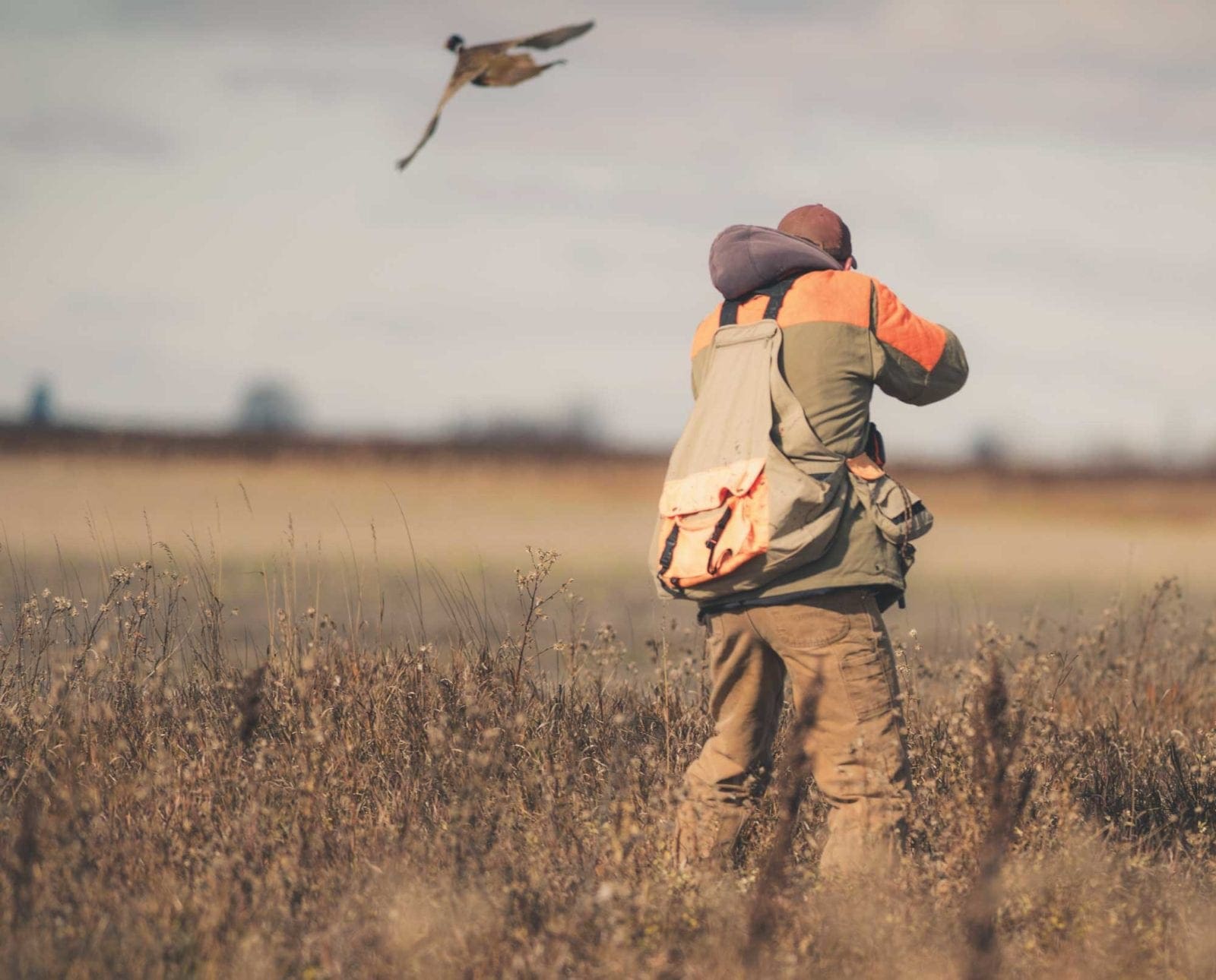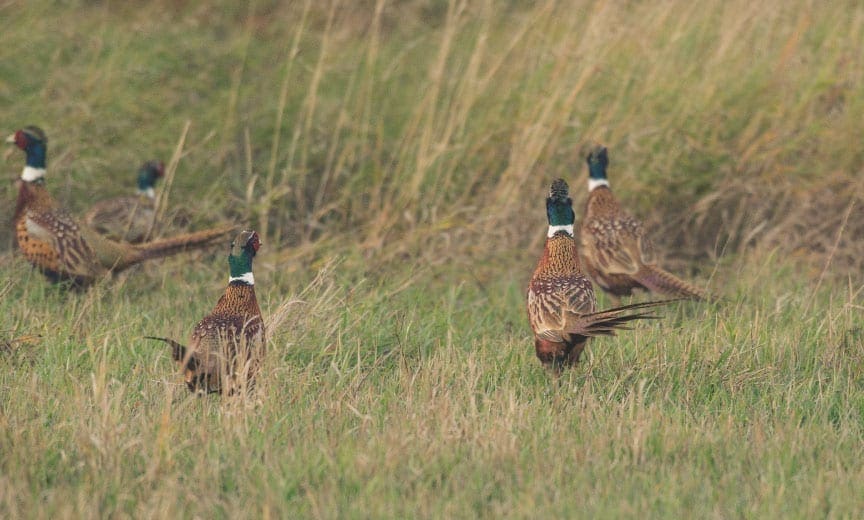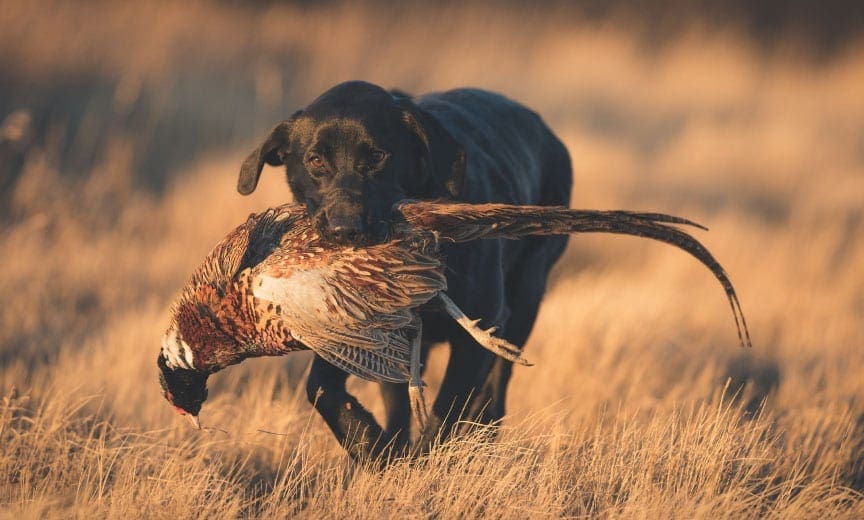Home » Pheasant Hunting » Hunting Heavy Pressured Pheasant
Hunting Heavy Pressured Pheasant

Edgar Castillo is a recently retired law enforcement officer for…
Run, hide, or fly: veteran pheasants have a way to avoid hunters that can be frustrating
Ring-necked pheasants are by their very nature shifty, sly, and some would say, diabolical. Aside from their bizarre field antics, pheasants are really not the fastest game bird in the uplands, nor are they the most difficult to hit with a string of pellets. But they are masters of avoiding being shot – just ask the multitude of hunters of how devious ring-necked pheasant roosters can be. Add in a late season pheasant hunt and things just keep staking up.
From the day they are born, pheasants realize they are food and at the top of the menu for coyotes, foxes, hawks, and during the autumn and winter months, for those orange-clad bipedal beings with their canine partners. Pheasants must rely on three primary survival strategies. In order to survive until the next morning, they MUST run, hide, or fly. The first two options are preferred and the third, only as a last resort. Understanding how roosters dodge the bullet will help hunters in dealing with these challenging birds.
There are two types of pheasants. There are the young and slightly dim-witted opening day birds that are the first to see the inside of a bird vest – and oven. Then there is the well-educated veteran rooster who literally runs circles around man and beast. Let it be known: a veteran is a pheasant that has had 24 hours of experience in avoiding hunters. From there, the roosters only continue to mature in avoidance tactics. It’s almost as if they all attend the military’s elite Survival, Evasion, Resistance, and Escape (SERE) schools!
The most common pheasant hunting fantasy story in hunting literature and real life is the cockbird that follows the rules of engagement when being hunted and pursued. The pheasant holds tight for a pointer or flushing breed and explodes noisily with a series of cackles. The colorful bird climbs nearly vertical before leveling out to a horizontal flight pattern. This by-the-book scenario, theoretically, is ideal for the hunter to make lethal contact with the colorful clown prince of the prairie.
This scenario, however, has problems ingrained with it. These “book pheasants” are becoming rarer as the season progresses. Pheasants are learning to avoid on-the-go. They are evolving each time bands of bird hunters step out onto the fields. Their defense mechanisms are being tweaked as they are being hunted, thwarting the most experienced of hunters and dogs. Pheasants learn to flush out of range at the hint of trouble, refusing to hold in place. Then again, some long-tail roosters hold sooo tight, they practically have to be launched into the air with a series of kicks. Others are downright cowardly, using harems of female pheasants to lure dogs and hunters away. Some hens tend to even draw strings of pellets by surprised and over-anxious hunters not realizing it is the drab-colored brown and tan hen as opposed to the raucous and colorful ring-necked pheasant. While this is happening, the sneaky and gutless rooster is duckin’ and runnin’ trying to put as much distance as possible between him and his pursuers.
As each hunting season progresses, surviving males become fewer in number but vastly smarter, individually. That’s especially true of birds on heavily hunted public land. When you consider that most pheasants spend much of their lives in a half-mile sized area, it doesn’t take a rocket scientist to figure out what the sounds of approaching pickup trucks, chattering hunters and noisy canines mean. Think about it. At popular or well-known public hunting areas, most hunters park in the same spots, make the same noises, and use the same ingress and egress routes day after day, season after season. It’s small wonder the birds don’t win every match.
3 rules for hunting veteran roosters
Educated long-tail roosters require a different approach and attitude than those which are often bagged by over-confident opening day hunters. Veteran ring-necks have been able to avoid both hunter and dog since the first crack of a shotgun on that first morning of the season. In order to combat the ring-necked rooster’s uncanny ability to run, hide, and fly, hunters need to adopt and employ countermeasures in order to be successful in the field.
Move in silence. Walk slowly. Know where to hunt. Easier said than done. Bird hunters need to adopt these two relatively simple, yet often ignored tips: refrain from making noise and rushing in. It’s the time to buckle down or the disappointment of walking out of the field with empty bird vests will be the norm.
As the saying goes, “Silence is Golden.” This can’t be repeated often enough. Many hunters have such a difficult time instituting even a little bit of noise discipline throughout the hunt. The mere sound of closing truck doors will cause pheasants to flush prematurely, head for those escape routes, and run for their lives. It should be obvious for hunters that it is mandatory they be quiet. It is understandable that not all noise can be eliminated, but we’re talking about unnecessary noise. Hunters need to use common sense when working a field and controlling dogs. Communication is important and vital for success when pheasant hunting. Pheasant hunting is typically a group activity and therefore communication between hunters is a must in order to convey plans and tactics.
Once in the field, hunters cannot go in blazing. Slow down! Moving in fast creates noise and hunters may pass tight-holding birds or drive running birds out of shotgun range. These errors will cost birds in the bag, but will also give those super-wary birds the chance to live another day. Walk and work the field slowly, pausing frequently. Following this stop-and-go pattern, hunters can generally unnerve roosters into flushing that are keen to holding tight until the threat passes.
It’s been established that walking slowly is crucial, but working a field thoroughly also plays a part. Hunters must scour the land and every bit of cover that may hold birds. Examples include islands of weeds, hedgerows, thickets, brush, overgrown crops and roadside ditches as well as thick cover and cattails along banks and shorelines of ponds, streams, or marshes. These sanctuaries provide pheasants the feeling of security.
Knowing where to look for birds is the last vital piece of the puzzle. The best pheasant hunting is usually in areas where feed and cover are plentiful. Daily movement patterns are important to know and understand. Early in the day, birds are in or near roosting cover. By mid-morning they move to feed, preferably on such crops as soybeans, milo and corn. Pheasants move into nearby loafing cover in the early afternoon, and return to roosting sites at the approach of sunset.
Know your birds. Understand their survival strategies. Practice hunting discipline. And enjoy the hunt!
Edgar Castillo is a recently retired law enforcement officer for a large Kansas City metropolitan agency. He also served in the United States Marine Corps for twelve years. Edgar longs for the colors of autumn and frosty, winter days so he can explore the landscapes in search of wild birds in wild places. His passion lies in the uplands as he self-documents his travels across public lands throughout Kansas hunting open fields, walking treelines, & bustin’ through plum thickets.






Great article. I recently went on a pheasant hunt and sadly we didn’t have enough time to really get after it but next time we go, we’ll keep this article in mind
Well definitely let me know how you do and if what I wrote helps. Good luck.
This was my first pheasant season. I was able to put a handful of birds in the air and folded two out of the sky – but when I got to where they fell they were nowhere to be found! My understanding is that they can sometimes hit the ground running for a bit – I’m sure the foxes thanked me that evening.
I”m sure the foxes enjoyed their delicious meal that you helped them get.
Another trick besides slowing down is to stop and count to 10, I had a lot of smart old birds flush with this method of hunting…
Good tip. I’ll keep this in mind.
I worked as a wildlife manager in a midwestern state and did a lot of work with pheasants. I used to watch hunters ‘march’ through a field, get in their vehicles and rush off to the next field…then I’d go through the field (still do this BTW) with my trusty slow-working Labradors and find birds. Most hunters work way too quickly. Slow down and don’t wear out your hip flexors! You’ll see more birds. Great article!
Thanks Tim for the kind words. You are absolutely right, hunters need to slow down. Don’t let the excitement cost you birds in your vest.
Great Article
I work my labs on local driven pheasant shoots here in Argyllshire , Scotland and you can see the birds get wiser and wiser as the season progresses. A cock bird having survived one season or even two is certainly wily and will test the best dogs and guns. Great advice about taking your time and letting the dogs steadily work through thick cover. These birds know the game and will sit tight , right till the last minute or make a run for it the minute they here a noise.
Thanks for sharing your experience and passing on your advice.
Mr. Findlay thank you for the kind words. My goal is always to pass on my experiences in the hopes that it helps or benefits others. Good to know that roosters across the ocean are just as wily and diabolical as they are here. Happy hunting.